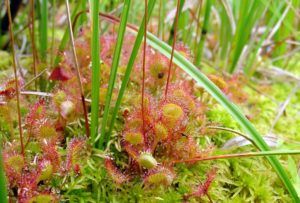The sundew is a diminutive but deadly insectivorous cousin of the Venus flytrap. Its genus name, Drosera, comes from the Greek word meaning ‘dewy’, a reference to the plant’s glistening droplets of sticky liquid mounted at the tips of touch-sensitive tentacles.
Resembling sweet-smelling crystal balls, they serve to fatally attract all manner of flying insects. The hapless creature that alights on this surface begins a futile struggle to free itself from adhesive bonds that are like living flypaper.

The more the prey panics, the more its fate is sealed, because each movement signals the sundew to releases yet more of the glue-like substance.
The tentacle-bearing leaf blade encircles the now-entombed prey by a process of nearly instantaneous growth, simultaneously engulfing it in digestive juices. Within several days, all that remains of the sundew’s meal are the indigestible wings and exoskeleton.

Cranefly captured by sundew, illustrated by Christine Elder
Sundews belong to the genus Drosera, one of the largest genera of carnivorous plants, with over 194 species. They are found across the globe, from Alaska to New Zealand, with around 50% of the world’s species residing in Australia.
The round-leaved sundew, Drosera rotundifolia, is among the most common and widespread species, being found throughout the northern latitudes of the world from Alaska to Europe to Japan, as well as inhabiting wetlands in my own state of Oregon on the west coast of the United States.

Common Sundew , photo by Noah Elhardt
Explained by Charles Darwin
Charles Darwin was the first to demonstrate the sundew’s carnivorous habits when he conducted experiments in 1860 proving the juices it secretes are similar to the enzymes found in the stomachs of animals. In 1875 he published the book, Insectivorous Plants, about his findings of this and other species of carnivorous plants and was among the first scientists to acknowledge the existence of truly flesh-eating plants.
Why would a plant opt for such a specialized lifestyle? Because most carnivorous plant species reside on nutrient-poor soils. These environments are largely competitor-free habitats, where carnivores thrive on nutrient-rich insects.
Learn more about the fascinating world of carnivorous plants




